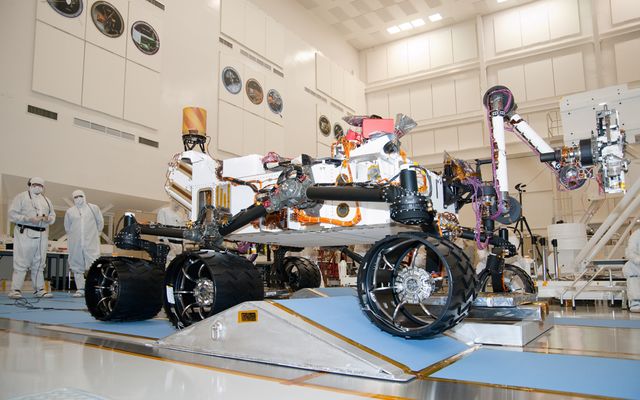Curiosity Mars Rover,monster truck for mars
CAPE CANAVERAL, 27 NOV: Nasa's Curiosity rover, the biggest, most
sophisticated robotic explorer ever built, blasted off on a journey to
Mars, where it will hunt for signs that life once existed there.
Curiosity, which is the size of a large car and weighs in at one ton,
has a laser beam for zapping interesting rocks and a tool kit for
analysing their contents.
It carries a robotic arm, a drill, and a set of 10 science instruments including two color video cameras. Sensors will enable it to report back on the Martian weather and the levels of radiation in the atmosphere ~ important data for Nasa as it devises future human exploration missions.
Known formally as the Mars
Science Laboratory (MSL), the spacecraft launched at 10.02 a.m. (1502
GMT) atop an Atlas V rocket to begin its nearly nine-month trip to the
Red Planet. 

Specification and features:
SIZE: 10 ft (3.0 m) in length, and weighs 1,984 lb (900 kg) including 176 lb (80 kg) of scientific instruments
Speed: Max 90m/hr on auto navigation ,Avrg 30m/hr expected according to terrain and poer level.
Power Source: radioisotope thermoelectric generators (RTGs) developped by Boeing using natuarlan ssecay of plutonium isotope "Multi-Mission Radioisotope Thermoelectric Generator" or MMRTG.Will produce 125 watts of electrical energy at stating of the mission.Expected life is min of 12 yrs.
HeatRejection System:liquid transfer heat using 60m tube from the component generating heat and MMRTG to other areas,also have facility to cool down.
Onboard Computer:Radiation hardened 2 boards (1active one redundant) based on RAD750 CPU, 256EEPROM,256RAM,2GB memory.
Communication: 2 ways, one XBand antena to directly communicate to earth, one UHF Electra (main communication) to communicate to earth via bigger Mars orbiters antenas.At landing time 13min 46 sec commiunication delay between Earth and mars.
Mobility Syatem: 6 wheeled rocker-bogie system.Each wheel has grooving that creates pattern on mars sanduy surface.pattern moorse code "JPL" (·--- ·--· ·-··),Onboard cam can capture the pattern and calculate the distance traversed.
Payloads:
Cameras: 1)MastCam: 2 camera true color 1600x1200 pixel, can take hwcompressed 720p video 10frame/sec,[8GB local memory for each], 2.1 to infinity auto focus
2)Mars hand Lens Imager(MAHLI)-Microscopic camera on Arm resolution around 14.5 micrometers / pixel.
3)MSL Mars Descend Imager (MARDI) : will take image while landing to map the landing site.
ChemCam:Remote Sensing instrument having first laser-induced breakdown spectroscopy (LIBS) system(can target from 7m and vapourizes in micrometer level and analyse the spectrum)cost 105M$ + 1.5M overrun
Alpha particale X-ray spectrometer (APXS): release alpha particale and analyse the sample (?)
CheMin: Chemical & mineralogy X-ray defraction instrument.
Sample Analysis Module (SAM): To analyze organic and gases.
Radiation Assessment Detector(RAD) : Near mars surface radiation assessment module for future human mars exploration.
Dynamic Albedo of neutrons (DAN): Neutron source and detector to detect hydrogen,water, ice at surface or near surface.
Rover Environmental monitoring Station (REMS):Metarological package and ultraviolet sensor
MSL entry and descend landing Instrumentation (MEDLI): Measure environment while descending for future missions.
Hazard Avoidance Camera (Hazcams) : Two pairs of b/w camera mounted fron and rear end as extra safeguard to avoid obstacles.
Navigational Camera (NavCam):A pair of B/W camera mounted on mast to navigation.

Comments